Hong Kong’s recent mass testing for COVID-19 involved a complicated logistics operation. Logistics workers, coders and moving vans all raced against time to optimize deliveries to the lab. Kathy Zhang reports.
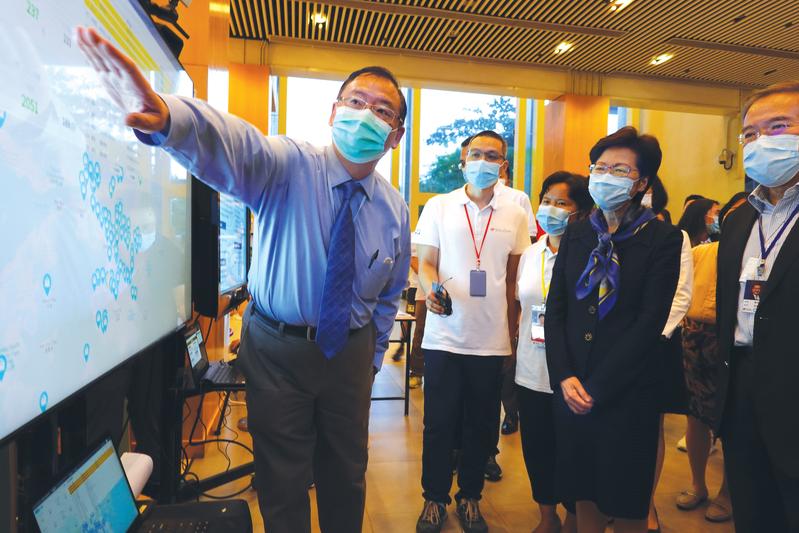 Simon Wong (left), chief executive officer of Logistics and Supply Chain MultiTech R&D Centre, shows the workings of its logistics system for the mass testing campaign during a visit by Chief Executive Carrie Lam Cheng Yuet-ngor (right). (PHOTO PROVIDED TO CHINA DAILY)
Simon Wong (left), chief executive officer of Logistics and Supply Chain MultiTech R&D Centre, shows the workings of its logistics system for the mass testing campaign during a visit by Chief Executive Carrie Lam Cheng Yuet-ngor (right). (PHOTO PROVIDED TO CHINA DAILY)
Pun Kwong-man and logistics workers were eagerly awaiting the first package to arrive — a box of saliva and nostril swabs taken from more than 300 Hong Kong people. Behind them stood medical workers in full protective gear.
It was the start of an unprecedented, arduous two-week-long exercise geared to help contain the most serious wave of coronavirus infections so far in Hong Kong that surged in July — the Universal Community Testing Programme for local residents.
Their jitters and hails at seeing the first box were quickly replaced by anxiety as boxes kept flooding in. The queue was soon long enough to create a traffic jam in the car park and the road leading to Sun Yat Sen Memorial Park Sports Centre in Sai Ying Pun, Hong Kong Island, where 16 air-inflated testing tents were built for the Huo-Yan Laboratory.
With a clear division of responsibilities, one of Pun’s colleagues used a cellphone to scan the QR code on the box to confirm the information before printing it out and passing the label and the box on to the medical staff.
Meanwhile, the now-empty van was being directed to a designated area in the parking lot for disinfection. It took seamless cooperation of several people to maintain the flow.

A running web
The entire process took the team roughly seven minutes on the first day. It was repeated an average of 500 times for the next 13 days, with the processing becoming as efficient as an assembly line churning out products in the blink of an eye.
From there, the dots in the puzzle for the mega project were connected. Pun and his team weaved together 141 community testing centers scattered across the city, and delivered more than 7,000 boxes containing more than 1.78 million samples to some 1,000 medical staff working round the clock to identify asymptotic coronavirus patients in the community.
Each day, more than 150 vehicles were involved in the entire logistics operation, some of which would deliver samples from sample collection centers at noon and in the evening after all the collection centers had stopped operating for the day.
Pun plays a key role in the Logistics and Supply Chain Multi-Tech R&D Centre (LSCM), a technology R&D institute funded by the Hong Kong government. The LSCM allocated two-thirds of its manpower — about 100 employees — and hired some 1,000 logistics workers from an outsourced company to back up the exercise.
Under the universal testing program, the LSCM employees were mainly in charge of monitoring, coordinating and developing the logistics operation, while the outsourced company was responsible for delivering the samples.
Every move in this giant web, orchestrated by the center, had to be carefully calculated to ensure there would be no “butterfly effect”, and to guarantee that people could get their test results the day after submitting their samples.

Even on days when there were fewer samples, Pun and his colleague David Leung — leaders of the 20-person team at the Sun Yat Sen Memorial Park Sports Centre — had to work 12 hours to keep the web running. Although they had discussed and revised the delivery arrangements and the working procedures several times before the program began, no one could predict what would happen in a real “combat” scenario, said Pun.
Despite their preparedness, a bump on the road soon occurred. The lab required a label to accompany each box, stating the center where it came from and how many samples it contained. Pun soon got programmers to work out a solution after reporting the request to the command center set up by the LSCM for the project.
Young coders soon developed a program, using computers at a testing center, to send information to the lab when a box was delivered. Pun and his team would then print it out on a label, and put the label on the box before handing it to the medical workers.
“Besides samples and empty boxes, we had to deploy universal transport medium (UTM) for conserving and transporting clinical specimens to different testing centers every day,” said Simon Wong, the LSCM's chief executive officer.
When a testing center was running out of UTM, the command center would contact the outsourced company which would use an emergency van to deliver supplies.
The command center and the contingency response center, testing centers, labs and the UTM warehouse were linked by a cloud-computing system.
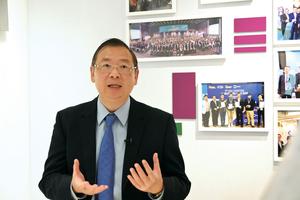 Simon Wong speaks to China Daily during an interview on Monday. (WILSON CHEN / CHINA DAILY)
Simon Wong speaks to China Daily during an interview on Monday. (WILSON CHEN / CHINA DAILY)
‘Unprecedented’ logistics
“This is the first time we’re responsible for such a large-scale program, and the time was limited. We didn’t have a chance to test before the program got underway,” Wong said.
The LSCM spent two weeks developing the backup system to streamline the city’s “unprecedented”, “super large-scale” logistics operation before the testing started to protect residents’ privacy.
The center’s researchers designed a collection box with a Bluetooth tracker to trace its real-time location. Every collection box came with a QR code, which worked with cellphones.
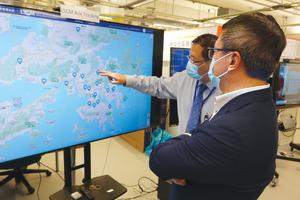 A map at the company’s command center shows the real-time locations of vans delivering samples for COVID-19 tests. (PHOTO PROVIDED TO CHINA DAILY)
A map at the company’s command center shows the real-time locations of vans delivering samples for COVID-19 tests. (PHOTO PROVIDED TO CHINA DAILY)
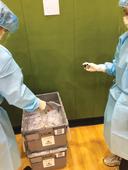 A medical worker puts a test sample into a Bluetooth-enabled collection box developed by the logistics technology company. (PHOTO PROVIDED TO CHINA DAILY)
A medical worker puts a test sample into a Bluetooth-enabled collection box developed by the logistics technology company. (PHOTO PROVIDED TO CHINA DAILY)
When a collection box was sealed, employees at different testing centers would use an app on their phone to scan the QR code on the box, as well as the QR code on the seal. The collection box could be transferred only if the two QR codes matched.
When drivers arrived at testing centers to pick up the boxes, they had to show their QR codes on their phone, which had to match those of the employees at the testing centers. “This step is to verify the identity of the deliverymen,” said Vincent Wong, assistant director of the LSCM’s technology development department.
A cloud-computing system was incorporated with the collection boxes. The command center could monitor the real-time location of all the boxes, as well as whether the testing centers had adequate boxes. “Employees at the command center could be informed of any incident immediately and then follow up,” said Simon Wong.
Had it not been for the staff’s commitment and research and development efforts in the past few years, the LSCM couldn’t have come up with such a logistics and sample-tracing system within such a short time, he said.
The COVID-19 pandemic has created opportunities for the science-technology sector and showed technology can help the world solve its problems, said Simon Wong, appealing for more funding for sci-tech research and development.
 A collection box is sealed with a unique QR code. (PHOTO PROVIDED TO CHINA DAILY)
A collection box is sealed with a unique QR code. (PHOTO PROVIDED TO CHINA DAILY)
 A logistics worker scans the QR code on a sealed collection box at a testing center. (PHOTO PROVIDED TO CHINA DAILY)
A logistics worker scans the QR code on a sealed collection box at a testing center. (PHOTO PROVIDED TO CHINA DAILY)
“The program also gave us a valuable opportunity to communicate with professionals from the mainland, and see how they built the 16 inflatable temporary labs and got all the facilities ready for the testing program within such a short time. We’ve learned the new technology they’ve adopted,” he said, adding that such communication is important for the development of sci-tech.
Leung said the mainland medical experts at the lab were very cooperative and tolerant of the chaos in coaches’ picking them up, or jams caused by the delivery vans in the small car park outside the lab.
During his rare meetings with some mainland medical experts over meals, Pun observed they always finished their meals within half an hour and dashed back to work.
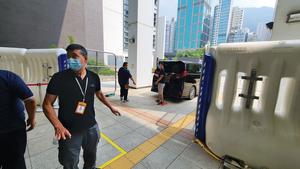 Pun Kwong-man, strategy officer of the Logistics and Supply Chain MultiTech R&D Centre, directs COVID-sample traffic at the Sun Yat Sen Memorial Park Sports Centre. (PHOTO PROVIDED TO CHINA DAILY)
Pun Kwong-man, strategy officer of the Logistics and Supply Chain MultiTech R&D Centre, directs COVID-sample traffic at the Sun Yat Sen Memorial Park Sports Centre. (PHOTO PROVIDED TO CHINA DAILY)
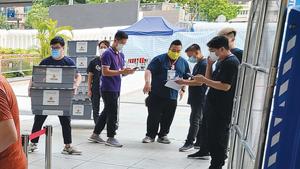 Workers drop off sample collection boxes at the Sun Yat Sen Memorial Park Sports Centre. (PHOTO PROVIDED TO CHINA DAILY)
Workers drop off sample collection boxes at the Sun Yat Sen Memorial Park Sports Centre. (PHOTO PROVIDED TO CHINA DAILY)
 A logistics worker pushes a box of samples to the Huo-Yan Laboratory at the Sun Yat Sen Memorial Park Sports Centre. (PHOTO PROVIDED TO CHINA DAILY)
A logistics worker pushes a box of samples to the Huo-Yan Laboratory at the Sun Yat Sen Memorial Park Sports Centre. (PHOTO PROVIDED TO CHINA DAILY)
Leung said he heard from a doctor from Maoming, Guangdong province, that his hospital had called for medical workers to sign up to support Hong Kong’s mass virus testing program, and the quota was full within an hour.
“I’m deeply moved by their support and spirit,” said Leung.
With a heavy heart, Pun said he and his colleagues felt they were always racing against time. They helped medical experts detect 42 infections, including 13 asymptomatic patients.
For Pun, he’s just one node in an intricate web. It reminds him of Hong Kong’s acclaimed “Lion Rock spirit” that can always withstand the test of time, affirming the fortitude and resilience of its people.
Contact the writer at kathyzhang@chinadailyhk.com


